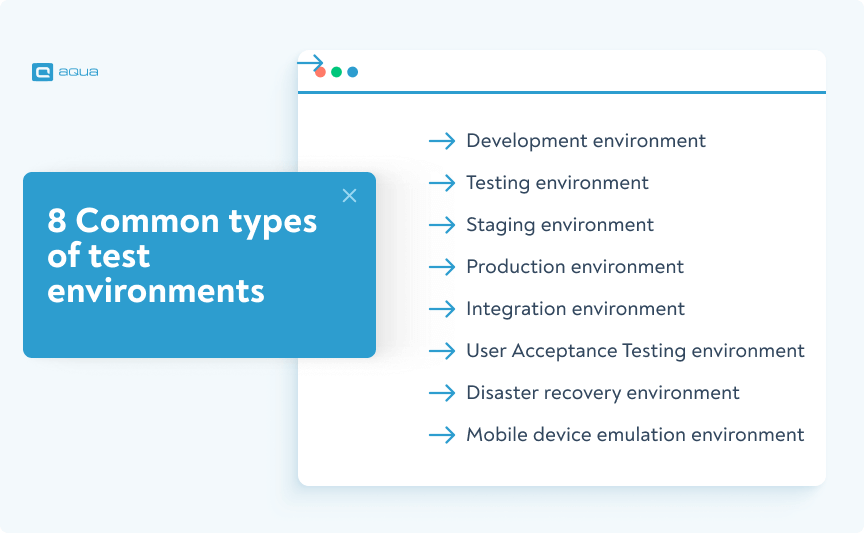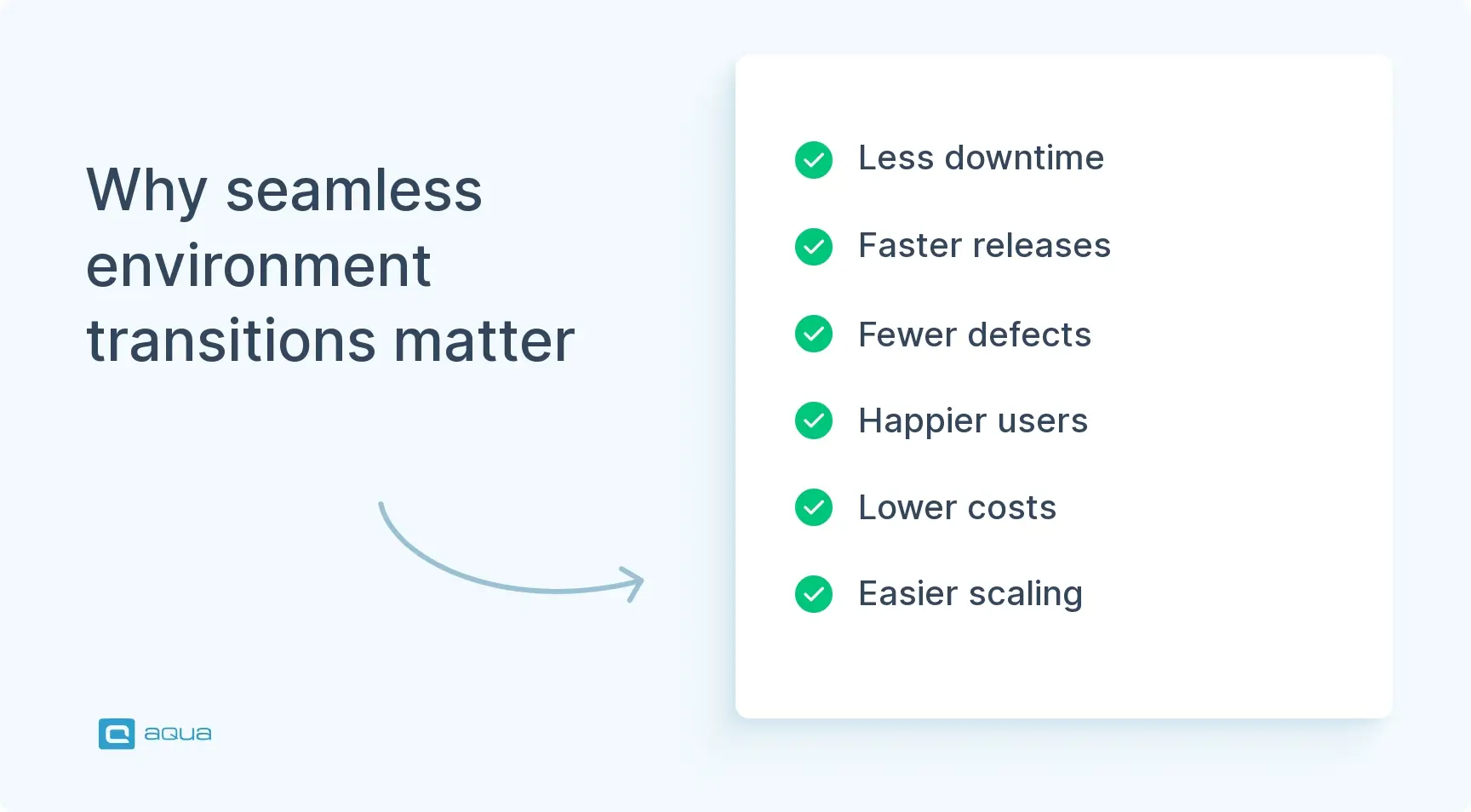This article dives deep into the world of test environment transitions, unravelling their key components, identifying their various types, and shedding light on why they’ve become a cornerstone in modern software development practices.
What are test environment transitions?
So, first things first. Before diving into comprehensive details, we should define these test environment transitions.
Test environment transitions blend process and tech. This includes CI/CD pipelines, IaC and containerisation. The goal is to move code smoothly between dev, QA, staging and production. When you implement these transitions correctly, you’ll catch bugs earlier while maintaining consistent configs. Start by automating just one transition point, as many teams see testing cycles cut nearly in half after focusing on dev-to-QA handoffs first. Think of them as the bridges guiding your software through its journey from development to testing, ensuring it’s well-prepared for its final destination – production. These transitions encompass a range of components, dependencies, and methodologies, all working harmoniously to streamline the development and deployment pipeline. Now, let’s delve deeper into the elements that make up this transformation.
What are the components and dependencies of test environment transitions?
After uncovering the essence of testing environment transitions, it’s time to examine their inner workings closely. Here are the essential components and dependencies that play pivotal roles in the world of test environment transitions:
- Application code: The core of any software transition, the application code represents the actual software product under development or enhancement.
- Test data: Test data is the input and output information used during testing to evaluate the application’s behaviour and functionality.
- Environment configuration: The specific settings and configurations of each testing environment, such as development, testing, staging, and production, are crucial to ensure consistency and reliability.
- Version control system: Tools like Git enable developers to manage and track changes in the application code, ensuring that everyone is working with the latest and most stable version.
- CI/CD pipelines: CI/CD pipelines automate the build, testing, and deployment processes, ensuring that code moves smoothly through different environments.
- Virtualisation and containerisation: This step involves using techniques such as virtualisation and containerisation, which allow you to create isolated environments. These isolated environments enhance consistency and portability in your test environment transitions. In other words, they ensure that your testing environment behaves predictably, regardless of where or how it’s deployed, which is crucial for a successful transition.
- Monitoring and logging tools: These tools help monitor the software’s performance and behaviour in real-time and offer insights into any issues that may arise.
- Collaboration and communication platforms: Effective communication and collaboration tools ensure that development and operations teams are in sync, enabling quick issue resolution.
- Documentation: Comprehensive documentation is vital for reference, ensuring that everyone involved understands the processes and dependencies.
These components and dependencies, when orchestrated effectively, weave the fabric of test environment transitions, making them the magic that drives a successful software development and deployment journey.
Common types of test environments
Now that we’ve unravelled the essential components and dependencies that shape the world of test environment management let’s explore the common types of test environments. As diverse landscapes define our world, different testing environments serve distinct purposes in the software development lifecycle. Understanding these environments is crucial for orchestrating seamless transitions.
Here are the common types of test environments that you would see in an ordinary software development and testing process:
- Development environment: This is where the process begins. Developers write, modify, and test code in this environment. It’s an open canvas for creativity and coding.
- Testing environment: Once code is developed, it moves to the testing environment for the QA team to test the deployed version. Here, quality assurance teams rigorously test the software for functionality, performance, and security while devs work on new changes.
- Staging environment: Staging is like a dress rehearsal before the big show. It’s a mirror image of the production environment, allowing teams to test software in an environment that closely resembles where it will be deployed.
- Production environment: This is the grand stage where your software goes live for end-users. It’s the environment where your application or website is accessible to the public.
- Integration environment: In this environment, different software components are integrated and tested to ensure they work seamlessly as a whole.
- User Acceptance Testing (UAT) environment: Before software hits production, it can be tested by actual end-users or stakeholders in the UAT environment to ensure it meets their expectations.
- Disaster recovery (DR) environment: This environment is designed to replicate the production environment in case of a catastrophic failure. It ensures business continuity and data recovery.
- Mobile device emulation environment: With the proliferation of mobile devices, this environment allows testing on various devices and platforms to ensure compatibility.

As test environment transitions are a critical aspect of software development, they present coordination, efficiency, and data management challenges. Test Management Systems (TMS) are invaluable tools for effectively navigating these transitions. A TMS is a central hub for test planning, execution, and reporting, playing a pivotal role in the smooth progression of testing activities across various environments. Here’s how TMS can enhance test environment transitions in general:
- Centralised Test Planning: TMS provides a unified platform for test planning, enabling teams to specify the target environments for testing, define test cases, and allocate resources efficiently. This centralisation eliminates confusion and promotes consistency in the transition process.
- Efficient Test Execution: With a TMS, test execution becomes more organised and traceable. Testers can easily select the designated environments for testing, execute test cases, and record results. This structured approach reduces the chances of errors and discrepancies during transitions.
- Traceability and Reporting: TMS tools offer robust traceability features, allowing you to monitor the progress of test cases in different environments. It enables real-time reporting, making it easier to identify and address issues promptly.
- Collaboration and Communication: TMS fosters collaboration among testing teams and other stakeholders involved in the transition process. It streamlines communication and ensures everyone is on the same page, which is crucial for a seamless transition.
- Data Management: TMS tools help in managing test data effectively. This is especially important during transitions, where data consistency across environments is vital to ensure testing accuracy and reliability.
Looking for a perfect solution that will help with all aspects mentioned above? That’s where aqua cloud comes in. With testing tool aqua, you have the power to enhance the efficiency of test environment transitions. With 100% traceability, it maintains a history of test runs. aqua streamlines defect management by specifying the target environment for raised defects, supports collaboration among your team members and efficiently manages test data. These features ensure that testing is well-organised, promotes precision, and ultimately elevates the quality of your software as it moves through various development stages. Get started with aqua cloud today to see the power of TMS in test environment transitions.
Master your test environment management with an AI-powered solution
The importance of seamless transitions
It’s essential to understand precisely why seamless transitions hold such immense importance in software development and deployment. These shifts aren’t just convenient but the backbone of efficiency, quality, and customer satisfaction. Let’s delve into seamless transitions’ significance to appreciate their magic fully.
Here’s why they matter:
- Minimising downtime: Seamless transitions ensure that your software moves from one stage to another without disruptions. This means less downtime for your application or website, which is critical for user accessibility and trust.
- Accelerating time-to-market: By reducing the time it takes to transition from development to testing and ultimately to production, you can get your software in the hands of users faster, gaining a competitive edge.
- Enhancing QA: Smooth transitions enable thorough testing in controlled environments, resulting in higher-quality software with fewer bugs and issues when it reaches the end users.
- Boosting user satisfaction: When software updates or new features are seamlessly deployed, users experience a consistent and reliable service, leading to higher user satisfaction and retention.
- Cost efficiency: Efficient test environment transitions lead to cost savings. They reduce downtime, expedite deployments, and promote efficient collaboration, resulting in increased productivity and quicker time-to-market, ultimately saving resources and enhancing the organisation’s financial efficiency.
- Flexibility and scalability: Seamlessly transitioning from one environment to another allows your software to adapt to changing requirements and scale effectively.

In essence, seamless transitions are the thread that weaves together all the stages of software development and deployment, ensuring that the result is a high-quality product that meets user expectations. It’s the change that makes software development efficient and delightful for developers and end-users.
Cutover Planning: The Critical Go-Live Transition
The cutover phase is where the rubber meets the road – that pivotal moment when your release transitions to production. A rock-solid cutover plan drastically cuts your risk during this make-or-break phase. Get this right by mapping dependencies, setting clear timelines, prepping both migration and rollback strategies, and making sure everyone knows their role. Smart teams do a dry run first. These rehearsals validate your readiness, confirm who’s handling what, and often reveal hidden dependencies you might have missed.
When go-live day arrives, tight control is key – restrict access, manage activities closely, and thoroughly verify everything post-deployment. About 40% of failed releases can be traced back to inadequate cutover planning. Create a minute-by-minute schedule with designated decision points where you can pause or proceed. Nail this, and everything before it pays off.
Traditional Test Environment Transitions: The Old Way
Exploring the paths paved by traditional approaches to test environment transitions is essential in understanding test environment transitions. These approaches, although once effective, also had their limitations and drawbacks. They served as the foundation for the modern transitions we now witness, and understanding their limitations is crucial for appreciating the advancements we’ve achieved. So, let’s step back in time and delve into the methods of old.
Manual server setup, patchy automation, and weeks-long provisioning delays. Sounds similar? Welcome to traditional test environments. They’re notorious for expensive, underused hardware and those frustrating “it worked on MY machine” issues.
Poor traceability is the worst offender here when your team can’t pinpoint which version was actually tested before release. You should start improving today by automating just one repetitive configuration task. Many teams see environment setup times cut nearly in half with this first step.
While these traditional approaches were the norm for a considerable time, they came with their fair share of challenges. Fortunately, the magic of modern technology and practices, such as containerisation, Infrastructure as Code, and CI/CD pipelines, has transformed test environment transitions, making them more efficient, reliable, and agile. These advancements have breathed new life into the world of software development, ensuring that past challenges remain in the annals of history.
What is the “magic” in seamless transitions?
Now, let’s unveil the “magic” that has truly transformed the landscape of seamless transitions in software development. These innovations have reshaped how we orchestrate transitions, making the process more efficient, reliable, and enchanting. Let’s delve into the spellbinding world of these transformative elements.
- Containerisation: Containerisation, represented by technologies like Docker and Kubernetes, is a game-changer in software development. Containers encapsulate applications and their dependencies, creating a portable and consistent environment. This means that code packaged in a container runs reliably across different stages of development, from the developer’s laptop to testing environments and production servers. Containerisation enhances consistency and simplifies deployment, making it one of the cornerstones of seamless transitions.
- Infrastructure as Code (IaC): Imagine being able to define your entire infrastructure—servers, networks, and configurations—as code. With Infrastructure as Code, you can do just that. Tools like Terraform and Azure Resource Manager allow you to automate the provisioning and management of infrastructure, ensuring that your environments are consistent, reproducible, and version-controlled. IaC brings precision and predictability to test environment transitions that were once unimaginable.
- CI/CD Pipelines: Continuous Integration and Continuous Deployment (CI/CD) pipelines are the engines driving software delivery. These pipelines automate your code’s building, testing, and deployment, ensuring that it moves seamlessly through various environments. CI/CD accelerates the development process and minimises human errors, making it a vital part of the magic behind seamless transitions.
These three elements, containerisation, Infrastructure as Code, and CI/CD pipelines, form the modern magic transforming test environment transitions. They enable software to glide effortlessly from development to testing to production, bringing a newfound consistency, reliability, and efficiency. It’s as though we’ve conjured a powerful spell to ensure that software transitions are no longer a challenge but a magical experience.
Modern Automation: Building Reliable and Traceable Transitions
Top-performing companies crush their test environment transitions through smart automation and clear tracking. Automated CI/CD pipelines shuttle code between environments and trigger tests automatically. Want consistent environments? Infrastructure as Code (IaC) solves this by making dev, QA and production setups practically identical. Containers are another game-changer; they wrap up applications so they run the same way everywhere – kiss those “but it worked on my machine” headaches goodbye.
A solid Test Management System ties everything together by connecting requirements directly to test cases and results. This visibility lets you trace exactly what was tested and when – crucial for troubleshooting or compliance.
The real deal is when teams combine these approaches. You can spin up new environments in minutes instead of days, roll features out gradually with blue/green deployments, and always know what’s running where. Start small by containerising one application component. Many teams see deployment issues drop by half almost immediately. Your releases will flow faster, with fewer surprises and way more confidence each time you push to production.
Conclusion
In conclusion, the journey through the world of test environment transitions highlights the transformative power of modern technology and practices. Successful app delivery hinges on the seamless movement of code, data, and processes across various environments, from development to production. Today, this transition is no longer manual and time-consuming but is achieved effortlessly through CI/CD, Infrastructure as Code (IaC), containerisation, and team education. This shift marks an era of efficiency, consistency, and reliability, bidding farewell to the limitations of traditional methods and embracing a new, more streamlined approach to software development.
Now, to weave this magic into your software development journey, you need the key to unlocking its full potential. This key is just a few clicks away from completely transforming your test environment management, and it is called aqua cloud. As a test management solution, aqua cloud empowers testing efforts across different environments. It allows you to specify the target environment for each raised defect, maintains a history of test runs in various environments, and aids in creating a traceability matrix to track test coverage. These built-in features streamline your testing process, ensuring precision, efficient collaboration, and the quality of your software as it advances through different development stages. Ready to experience the capabilities of aqua cloud? Don’t hesitate; try it for free and witness the pain of testing taken away from you.
Get the modern solution you need for the test environment transition


















